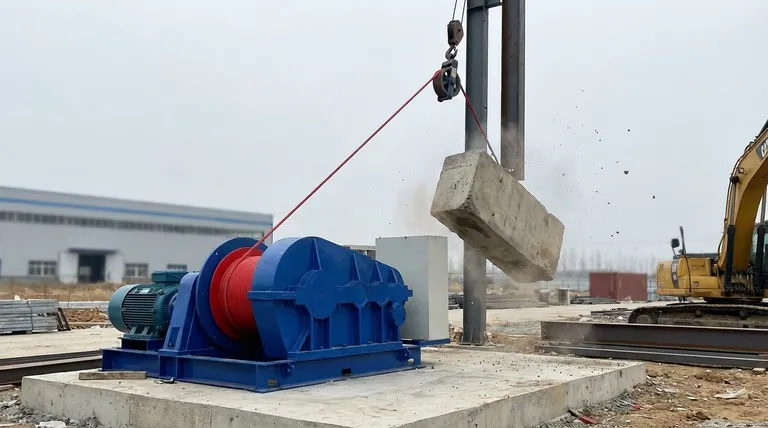Crucially, a 3000 lb winch does not lift 3000 lbs. This rating refers to its horizontal pulling capacity, not its vertical lifting ability. For vertical lifting, a typical 3000 lb winch is rated for a much lower weight, often in the range of 600-700 lbs, due to the direct force of gravity and different mechanical stresses.
The single most important takeaway is that winch ratings measure horizontal pulling force under ideal conditions. Vertical lifting capacity is a completely different, and drastically lower, specification that requires consulting the manufacturer's manual to ensure safe operation.

The Critical Difference: Pulling vs. Lifting
Understanding why a "3000 lb" rating is misleading for lifting requires a clear distinction between two very different types of work.
The "3000 lb" Rating Explained
The 3000 lb number represents the winch's maximum rated line pull. This is the force it can exert horizontally on the first layer of cable wrapped around the drum.
This rating assumes an ideal scenario: a static, rolling load on a flat, smooth surface. It's a measure of its ability to drag, not to lift.
Why Lifting Capacity is Much Lower
When you lift an object, you are working directly against 100% of its weight due to gravity. There is no friction from the ground to help distribute the load.
This places an immense, sustained strain on the winch's motor, gearing, and braking system, components that are primarily designed for the intermittent, high-torque work of pulling. For example, a winch with a 0.55KW motor is engineered for this specific task, not for supporting a dead-weight suspended load.
Winches vs. Hoists: The Right Tool for the Job
Devices specifically designed for vertical lifting are called hoists, not winches.
Hoists are built with different gearing and, most importantly, superior braking systems designed to lock and hold a suspended load safely without fail. A winch brake is often designed only to prevent rollback during pulling, not for the critical safety required in lifting.
Understanding the Risks and Limitations
Using a winch for a task it wasn't designed for is not just inefficient; it's extremely dangerous. Misinterpreting the capacity can lead to catastrophic failure.
The Danger of Exceeding a Winch's True Limit
Attempting to lift an object heavier than the winch's specified lifting limit can cause the motor to burn out, the gears to strip, or the cable to snap.
Most critically, the winch's braking system could fail, causing the load to drop suddenly and uncontrollably.
The Impact of Cable Layers
A winch's pulling power is strongest on the very first layer of cable wrapped around the drum.
With each additional layer of cable, the effective diameter of the drum increases, which reduces the gear ratio and decreases the available pulling force. Your 3000 lb winch might only pull 1500-2000 lbs when the cable is nearly all spooled in.
Making the Right Choice for Your Task
To select the correct equipment, you must be clear about your primary objective.
- If your primary focus is vertical lifting: You must use a dedicated hoist. Look for its "Working Load Limit" (WLL) and ensure it is significantly higher than the weight of your object.
- If your primary focus is horizontal pulling or vehicle recovery: A 3000 lb winch is appropriate for small vehicles or loads, but always account for factors like mud, sand, or inclines that increase the required force.
- If you are ever in doubt: Always select equipment with a capacity rating that far exceeds your heaviest estimated load and consult the manufacturer's specifications to confirm its suitability for lifting.
Ultimately, safety depends on using the right tool for the job as it was designed to be used.
Summary Table:
| Aspect | Pulling Capacity (Horizontal) | Lifting Capacity (Vertical) |
|---|---|---|
| Typical Rating | 3000 lbs (1st layer of cable) | 600-700 lbs (Consult manual) |
| Primary Function | Dragging/Recovery | Suspending a load |
| Key Design Focus | Intermittent, high-torque motor | Superior braking system for safety |
| Correct Tool | Winch | Hoist |
Don't risk equipment failure or operator safety by using the wrong tool.
GARLWAY specializes in providing robust and reliable construction machinery, including winches designed for powerful horizontal pulling and recovery tasks. For construction companies and contractors globally who need the right equipment for the job, our expertise ensures you get a solution that matches your specific requirements for performance and safety.
Contact GARLWAY today for a consultation on the right winch or hoist for your project's needs.
Visual Guide

Related Products
- Best 18000 Pound Drum Anchor Trailer Winch
- Electric and Hydraulic Winch for Heavy Duty Applications
- Heavy Duty Electric Boat Winch Windlass Anchor
- Warn Winch Windlass Boat Trailer Winch
- Hydraulic Concrete Mixer Machine Cement Mixing Equipment for Mixture Concrete
People Also Ask
- How are trailer winch sizes determined? Match Capacity to Your Boat's Weight for Safe Loading
- How do trailer winches benefit boat owners? Achieve Safe & Effortless Boat Loading
- What is the purpose of a trailer winch? Achieve Safe & Effortless Heavy Loading
- What is the primary function of trailer winches? Effortlessly Load Heavy Boats & Equipment
- How are trailer winches rated? A Guide to Safe & Effective Load Capacity



















